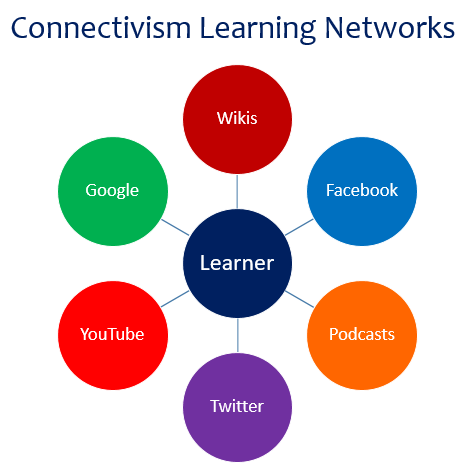Connectivism
Connectivism is a learning theory based upon the idea that learning takes place inside virtual networks and communities through social interaction. It is based on the idea that internet technologies have created new opportunities for people to learn and share information across networks.
About Connectivism
The theory of Connectivism was developed by George Siemens and Stephen Downes based on limitations of behaviorism, cognitivism, and constructivism to explain the effects technology has had on how we live, interact, communicate, and learn.
Their theory describes the process of learning which takes place through the building of online connections between people. Because the theory does not address transferring or creating knowledge, it is often thought more as an instructional theory or learning perspective, rather than a learning theory. It does integrate principles of different theories such as chaos, network, complexity, and self-organization. More accurately, their theory is about how we grow ourselves and our society in connected ways.
Digital Age Theory
Connectivism theory has developed with the digital age where technologies have enabled people to learn and share information through online networks. The theory emphasizes how internet technologies such as web browsers, search engines, wikis, online discussion forums, and social networks contribute to new opportunities for learning.
Networks and Nodes
Connectivism proposes that learning and knowledge does not simply happen within an individual, but within and across a series of networks of people sharing information to create integrated knowledge. An individual’s knowledge not only resides in their mind, but also in connections with both electronic and human components that the learner has engaged with in the course of their learning. An individual’s learning consists of their ability to construct, organize, and extract value from those networks.
Connectivism uses a network with nodes and connections as a central metaphor for learning. In this metaphor, a node is anything that can be connected to another node including information, data, feelings, or images. The learning process is seen as creating connections between these nodes to form a network. It is these connections between all the nodes in a network that result in new forms of knowledge.
Through these networks learners can;
- acquire new content
- identify credible resources
- draw distinctions between opposing facts and figures
- share their understanding of the topic with others
- acquire new information as content is continually updated
Learning Process
In Connectivism, the learning process does not simply happen within an individual, but within and across the networks. Knowledge is created beyond the level of the individual learner, and is constantly shifting and changing.
This learning process is cyclical. The learners will:
- connect to a network to find information
- modify their beliefs on the basis of new learning
- connect to a network to share their thoughts and understandings
- modify their beliefs based on feedback and new learning
- connect to a network to find new information to support or alter their understanding
Since information is constantly changing, its validity and accuracy may change over time as well. Therefore, the capacity to know is more critical than what is actually known.
Learning Abilities
With the amount of information in the various networks, individual learners need several important skills;
- the ability to seek out relevant information
- the ability to filter extraneous information
- the ability to draw distinctions between important and unimportant
- the ability to distinguish creditable sources
- the ability to connect to and exchange information within the larger community
- the ability to make decisions on the basis of information


